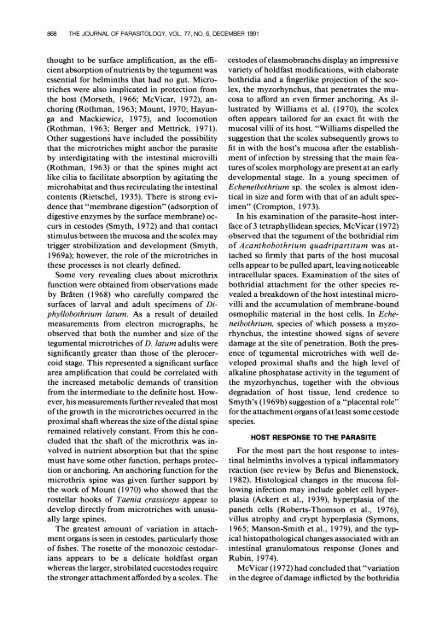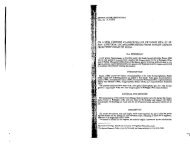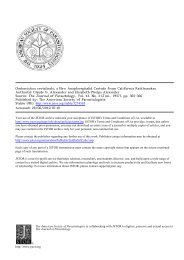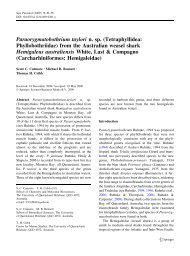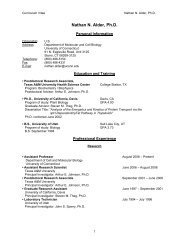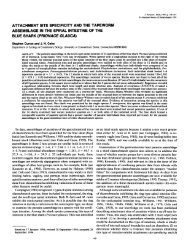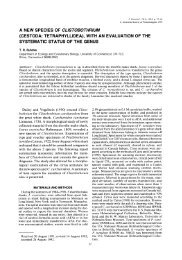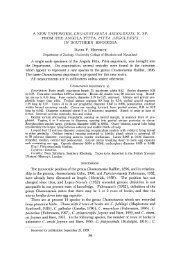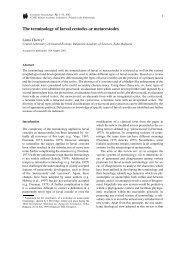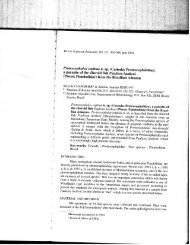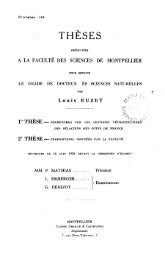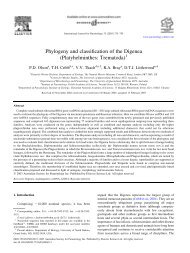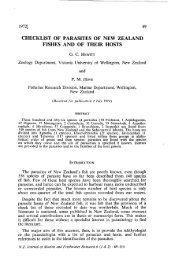Morphological Adaptations of Intestinal Helminths
Morphological Adaptations of Intestinal Helminths
Morphological Adaptations of Intestinal Helminths
Create successful ePaper yourself
Turn your PDF publications into a flip-book with our unique Google optimized e-Paper software.
868 THE JOURNAL OF PARASITOLOGY, VOL. 77, NO. 6, DECEMBER 1991thought to be surface amplification, as the efficientabsorption <strong>of</strong> nutrients by the tegument wasessential for helminths that had no gut. Microtricheswere also implicated in protection fromthe host (Morseth, 1966; McVicar, 1972), anchoring(Rothman, 1963; Mount, 1970; Hayungaand Mackiewicz, 1975), and locomotion(Rothman, 1963; Berger and Mettrick, 1971).Other suggestions have included the possibilitythat the microtriches might anchor the parasiteby interdigitating with the intestinal microvilli(Rothman, 1963) or that the spines might actlike cilia to facilitate absorption by agitating themicrohabitat and thus recirculating the intestinalcontents (Rietschel, 1935). There is strong evidencethat "membrane digestion" (adsorption <strong>of</strong>digestive enzymes by the surface membrane) occursin cestodes (Smyth, 1972) and that contactstimulus between the mucosa and the scolex maytrigger strobilization and development (Smyth,1969a); however, the role <strong>of</strong> the microtriches inthese processes is not clearly defined.Some very revealing clues about microthrixfunction were obtained from observations madeby Braten (1968) who carefully compared thesurfaces <strong>of</strong> larval and adult specimens <strong>of</strong> Diphyllobothriumlatum. As a result <strong>of</strong> detailedmeasurements from electron micrographs, heobserved that both the number and size <strong>of</strong> thetegumental microtriches <strong>of</strong> D. latum adults weresignificantly greater than those <strong>of</strong> the plerocercoidstage. This represented a significant surfacearea amplification that could be correlated withthe increased metabolic demands <strong>of</strong> transitionfrom the intermediate to the definite host. However,his measurements further revealed that most<strong>of</strong> the growth in the microtriches occurred in theproximal shaft whereas the size <strong>of</strong> the distal spineremained relatively constant. From this he concludedthat the shaft <strong>of</strong> the microthrix was involvedin nutrient absorption but that the spinemust have some other function, perhaps protectionor anchoring. An anchoring function for themicrothrix spine was given further support bythe work <strong>of</strong> Mount (1970) who showed that therostellar hooks <strong>of</strong> Taenia crassiceps appear todevelop directly from microtriches with unusuallylarge spines.The greatest amount <strong>of</strong> variation in attachmentorgans is seen in cestodes, particularly those<strong>of</strong> fishes. The rosette <strong>of</strong> the monozoic cestodariansappears to be a delicate holdfast organwhereas the larger, strobilated eucestodes requirethe stronger attachment afforded by a scolex. Thecestodes <strong>of</strong> elasmobranchs display an impressivevariety <strong>of</strong> holdfast modifications, with elaboratebothridia and a fingerlike projection <strong>of</strong> the scolex,the myzorhynchus, that penetrates the mucosato afford an even firmer anchoring. As illustratedby Williams et al. (1970), the scolex<strong>of</strong>ten appears tailored for an exact fit with themucosal villi <strong>of</strong> its host. "Williams dispelled thesuggestion that the scolex subsequently grows t<strong>of</strong>it in with the host's mucosa after the establishment<strong>of</strong> infection by stressing that the main features<strong>of</strong> scolex morphology are present at an earlydevelopmental stage. In a young specimen <strong>of</strong>Echeneibothrium sp. the scolex is almost identicalin size and form with that <strong>of</strong> an adult specimen"(Crompton, 1973).In his examination <strong>of</strong> the parasite-host interface<strong>of</strong> 3 tetraphyllidean species, McVicar (1972)observed that the tegument <strong>of</strong> the bothridial rim<strong>of</strong> Acanthobothrium quadripartitum was attachedso firmly that parts <strong>of</strong> the host mucosalcells appear to be pulled apart, leaving noticeableintracellular spaces. Examination <strong>of</strong> the sites <strong>of</strong>bothridial attachment for the other species revealeda breakdown <strong>of</strong> the host intestinal microvilliand the accumulation <strong>of</strong> membrane-boundosmophilic material in the host cells. In Echeneibothrium,species <strong>of</strong> which possess a myzorhynchus,the intestine showed signs <strong>of</strong> severedamage at the site <strong>of</strong> penetration. Both the presence<strong>of</strong> tegumental microtriches with well developedproximal shafts and the high level <strong>of</strong>alkaline phosphatase activity in the tegument <strong>of</strong>the myzorhynchus, together with the obviousdegradation <strong>of</strong> host tissue, lend credence toSmyth's (1969b) suggestion <strong>of</strong> a "placental role"for the attachment organs <strong>of</strong> at least some cestodespecies.HOST RESPONSE TO THE PARASITEFor the most part the host response to intestinalhelminths involves a typical inflammatoryreaction (see review by Befus and Bienenstock,1982). Histological changes in the mucosa followinginfection may include goblet cell hyperplasia(Ackert et al., 1939), hyperplasia <strong>of</strong> thepaneth cells (Roberts-Thomson et al., 1976),villus atrophy and crypt hyperplasia (Symons,1965; Manson-Smith et al., 1979), and the typicalhistopathological changes associated with anintestinal granulomatous response (Jones andRubin, 1974).McVicar (1972) had concluded that "variationin the degree <strong>of</strong> damage inflicted by the bothridia


